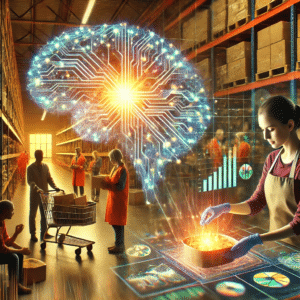
Artificial intelligence (AI) is no longer a tool reserved for tech companies and for-profit enterprises. AI and nonprofits are increasingly intersecting, as organizations adopt AI to revolutionize their operations, enhance their impact, and address pressing social issues. By leveraging AI effectively, nonprofits can optimize resource allocation, better engage with donors, and tackle complex global challenges such as climate change and inequality. Here, we explore how AI is transforming the nonprofit sector, highlighting key statistics and examples of its potential.
AI is reshaping the landscape of nonprofits in profound ways. According to a report by Google.org, 75% of nonprofit leaders believe AI could significantly enhance their organization’s effectiveness. This belief aligns with broader trends: the global AI market is expected to grow at a compound annual rate of 37% from 2023 to 2030, signaling its increasing accessibility and utility.
One critical way AI and nonprofits are transforming the sector is by streamlining operations. Administrative tasks such as data entry, donor management, and grant writing are often time-consuming but essential. AI tools, such as generative AI models, can automate these tasks, freeing up staff to focus on mission-critical activities. For example, some organizations use AI to draft personalized donor outreach emails, increasing engagement while saving time.
AI equips nonprofits with tools to leverage data more effectively, transforming strategic decision-making. Through predictive analytics, organizations can analyze historical trends and real-time information to anticipate donor behaviors, spot emerging funding opportunities, and identify high-impact initiatives. Research highlights that nonprofits utilizing AI for data-driven strategies experience significant improvements in resource allocation and program effectiveness, ensuring maximum impact from their funding.
For example, nonprofits addressing food security are increasingly adopting AI-driven systems to optimize their operations. One approach involves using satellite imagery and predictive modeling to assess agricultural productivity and identify regions most vulnerable to food shortages. These insights enable timely interventions, such as the pre-positioning of supplies or resource allocation for communities in need, reducing hunger more effectively.
AI also plays a critical role in mental health services. Crisis Text Line employs machine learning algorithms to analyze text messages from individuals seeking help. This technology assesses the urgency of each case in real time, prioritizing high-risk situations for immediate intervention. As a result, the organization can allocate resources more efficiently, providing life-saving assistance to those who need it most.
Moreover, the integration of AI into decision-making processes is fostering innovative solutions in global health. For instance, by utilizing predictive modeling, nonprofit healthcare providers can monitor patient data to identify emerging disease patterns. This approach not only enhances early detection but also guides preventive measures, ultimately improving health outcomes on a broader scale.
Fundraising remains a cornerstone of nonprofit sustainability, and AI is transforming how organizations connect with donors. By leveraging machine learning and donor data, nonprofits can identify giving patterns, segment their audiences, and create personalized campaigns that resonate with supporters. A report from Google.org highlights that AI-driven fundraising strategies have resulted in increased donor retention rates and higher average donation amounts.
For instance, The Nature Conservancy uses AI to predict donor likelihood to give based on historical contributions, engagement metrics, and demographic factors. This enables the organization to craft tailored appeals, increasing donor participation. Machine learning models also help identify optimal times to launch campaigns, ensuring that fundraising efforts align with donor behaviors.
AI is playing a pivotal role in addressing complex global challenges. Nonprofits are using AI to analyze vast amounts of data, optimize interventions, and drive systemic change in areas such as climate action, healthcare, and disaster response.
In the fight against climate change, Rainforest Connection leverages AI-powered acoustic sensors to monitor forests for signs of illegal logging. These sensors, combined with machine learning algorithms, detect sounds of chainsaws or vehicles in real time, enabling rapid intervention. This innovative approach has helped protect endangered ecosystems and combat deforestation effectively.
During natural disasters, AI and nonprofits have proven invaluable in coordinating relief efforts. The American Red Cross, for instance, uses AI models to predict the impact of hurricanes and other disasters. By analyzing weather patterns, population density, and infrastructure vulnerabilities, the organization can anticipate areas of greatest need and deploy resources more efficiently.
In healthcare, organizations are increasingly leveraging AI to monitor and predict disease outbreaks. By analyzing vast datasets, including health records and epidemiological information, AI systems identify patterns and emerging hotspots. For example, machine learning models can predict the spread of infectious diseases, enabling timely, targeted interventions that mitigate risks and save lives. This approach enhances public health preparedness and ensures resources are allocated where they are needed most.
Adopting AI is not without its hurdles. One significant barrier is the lack of technical expertise within many nonprofits. Limited budgets can also make it difficult to invest in AI tools and training. Additionally, smaller organizations may struggle to compete with larger nonprofits and for-profit entities for access to cutting-edge technologies.
Furthermore, the improper implementation of AI can lead to unintended consequences, as demonstrated by the National Eating Disorders Association (NEDA). In 2023, the organization faced significant backlash when its AI-powered chatbot, intended to provide advice to individuals seeking support for eating disorders, issued inappropriate and unhealthy recommendations. This incident highlights the importance of ensuring that AI systems are rigorously tested, ethically designed, and monitored to prevent harm, particularly when dealing with vulnerable populations.
AI and nonprofits hold immense promise for transforming the sector, offering innovative solutions to optimize operations, enhance donor engagement, and tackle global challenges more effectively. From predictive analytics driving data-driven decision-making to machine learning models reshaping fundraising strategies, the integration of AI is helping organizations amplify their impact.
However, this technological revolution is not without its challenges. Limited resources, a lack of technical expertise, and the risk of unintended consequences underscore the importance of careful planning and ethical considerations in AI implementation. By investing in training, partnerships, and robust testing processes, nonprofits can overcome these hurdles and harness AI responsibly.